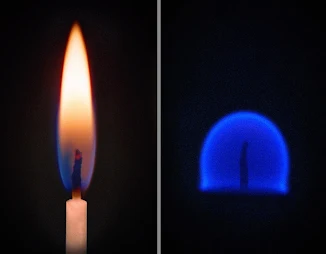The 2nd part of my article dealt with the methods of starting a fire and its underlying chemistry. In this part I would like to explain the characteristics of a flame with a pint of philosophy. Thus I feel free to quote Michael Faraday from his lectures, The Chemical History of a Candle. It goes like this, "There is no better, there is no more open door by which you can enter into the study of natural philosophy than by considering the physical phenomenon of a candle''.
Physics is an excellent subject, and perhaps the only one that can venture fearlessly into the very heart of reality. When physics reaches its saturation point, philosophy comes into action. And, our quest for knowledge goes on and on forever. With our tools-the laws of nature or the laws of science, we become capable of formulating some elegant theories. These theories then become the very foundations of reality.
A lot can be learned and understood about the laws of nature and science by just staring quietly towards a candle. The warm teardrop-shaped flame, glowing as a result of a few simple yet elegant chemical transformations, makes us contemplate about its hidden nature. But a candle flame sometimes meddles with the very notion of reality. What we see as light is ain't that simple. Likewise other phenomenon, light is also a product of atomic and molecular transformations. It is complicated but that has never been an excuse to hinder our quest for knowledge. So, let us go back to our candle.
Characteristics of a Flame: This is best explained by giving a detailed note on the structure of a candle flame.
Candle Flame: A candle flame can be divided into five distinct zones. They are as follows:
- Zone-1: This is located around the base of the wick. This is the non-luminous, lowest and the coolest part of the flame. Temperatures are around 600℃(873K).
- Zone-2: The blue zone surrounds the base of the candle flame. This is the region where oxygen enters into the flame. Being a clean burning zone the color of the flame in this region is a faint blue. The heat released here melts the paraffin wax, and the wick draws up the molten fuel via capillary action. Temperatures are around 800℃(1073K).
- Zone-3: The dark zone, just above the wick contains unburnt fuel. Pyrolysis takes place here and temperatures climb to 1000℃(1273K).
- Zone-4: The middle/luminous zone is yellow-white, situated above the dark zone. This is the brightest zone, but not the hottest as oxygen is completely depleted here. This zone also contains unburnt fuel and soot. Temperatures are around 1200℃(1473K).
- Zone-5: The non-luminous outer zone called the veil extends from the blue base to the top of the flame. Here oxygen directly mixes with the hydrocarbon molecules and temperatures rise to a whooping 1400℃(1673K). This zone glows with an extremely light blue color. Since our eyes can process yellow light better than blue light, so this zone remains largely invisible to us.
 |
| A loose necktie / CC BY-SA (https://creativecommons.org/licenses/by-sa/4.0) |
Action of Gravity on a Flame: The same old gravity has to act everywhere. The cosmos we see today exists because of gravity. So how come a little candle flame get away from its nasty clutch?
Why does a candle flame have a teardrop shape? And, why does a raging flame always advance upwards? These happen because air being heated around the flame gets lighter and rises up. The colder air is heavier and settles at the bottom. So the flame draws up colder, oxygen-rich air and releases the oxygen depleted hot air upwards. This hot air helps the fire to spread. Therefore, the candle flame takes a teardrop shape. This is also the reason why we should always move towards the lower floors when a building is on fire.
But in micro-gravity(like in space), a fire curves around its source and forms a spherical shape because gravity cannot influence the moving up and down of air molecules. Here's a picture.
 |
| Flames in different conditions Image Credits: NASA / Public domain |
What do we see while staring at a flame?
When we stare at a flame, we see light. But where does this light come from? Just give it a few seconds thought before you read the next sentence.
A flame is composed of reacting gasses, vapors and solid particles of carbon that can emit electromagnetic radiation in the visible and infrared region. The color depends upon the type of material being burnt and the also on the amount of oxygen being used up in the burning process.
The light is emitted due to two factors. Firstly due to incandescence and secondly due to transition of electrons within the atomic nucleus. The fine particles of soot are heated and they start to glow a dull red due to the phenomenon of incandescence. Secondly as energy is supplied, the C and O atoms gets excited as an electron absorbs energy. Thus it jumps from one atomic orbital to another. Again when it comes down to its original place of lesser energy, the excess energy gets converted into a photon. This excitation & de-excitation of electrons is revealed to us in the form of visible light.
My article ends here. It has been a wonderful journey, from the lighting of a simple match to the hidden world of chemistry. And this is what we call science.
A million years ago, our distant ancestors were perhaps bewildered when they unlocked the power of fire for the first time. But from the moment they started controlling fire, they unknowingly changed their future. Although, a simple matchstick is puny compared to the hell-fire of a volcano, but that small streak of light tells us a story about a million years of human civilization.
See you soon. Stay tuned for more.




Comments
Post a Comment